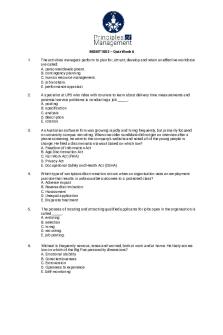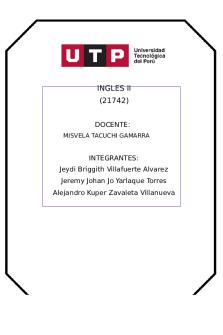NR 511 Week 6 Quiz 2021 - Quiz week 6 PDF

| Title | NR 511 Week 6 Quiz 2021 - Quiz week 6 |
|---|---|
| Author | Anne Greer |
| Course | Differential Diagnosis & Primary Care Practicum |
| Institution | Chamberlain University |
| Pages | 12 |
| File Size | 713.7 KB |
| File Type | |
| Total Downloads | 7 |
| Total Views | 172 |
Summary
Quiz week 6...
Description
4/5/2021
Week 6: Quiz: Differential Diagnosis and Primary Care Practicum-Feehan
Week 6: Quiz Points 15 Questions 15 Due Apr 11 at 11:59pm Time Limit 15 Minutes Available Apr 5 at 12am - Apr 11 at 11:59pm 7 days
Attempt History LATEST
Attempt
Time
Score
Attempt 1
15 minutes
14 out of 15
Score for this quiz: 14 out of 15 Submitted Apr 5 at 11:08am This attempt took 15 minutes.
1 / 1 pts
Question 1
An elderly client presents with atrial fibrillation. Which of the following lab tests is important in forming the diagnosis?
Correct!
Thyroid-stimulating hormone (TSH).
Atrial fibrillation is a common presentation in elderly clients with hypert thyroxine (
roidism. If the TSH is suppressed, a free 4) and triiodothyronine (T3) should be drawn.
https://chamberlain.instructure.com/courses/77585/quizzes/295763
1/12
4/5/2021
Week 6: Quiz: Differential Diagnosis and Primary Care Practicum-Feehan
Question 2
1 / 1 pts
A 24-year-old female is preparing for radioactive iodine therapy to treat Graves disease. Which test must she undergo first?
Correct!
Beta-human chorionic gonadotropin.
Radioactive iodine therapy is the most commonly used treatment in the United States for Graves disease (hyperthyroidism); however, it is contraindicated during pregnancy. Therefore, for women, a pregnancy test (betahuman chorionic gonadotropin) needs to be performed before initiating therapy. Women of childbearing age should also be told to delay conception for a few months after radioactive iodine therapy. It is also contraindicated in women who are breastfeeding. Older adults or clients at risk of developing cardiac complications may be pretreated with antithyroid drugs (ATDs) before therapy to deplete the thyroid gland of stored hormone, thereby minimizing the risk of exacerbation of hyperthyroidism because of radioactive iodine (131I)– induced thyroiditis.
Question 3
1 / 1 pts
A 46-year-old male presents with a tender, red and swollen knee. The clinician orders a complete blood count (CBC) with differential, https://chamberlain.instructure.com/courses/77585/quizzes/295763
2/12
4/5/2021
Week 6: Quiz: Differential Diagnosis and Primary Care Practicum-Feehan
uric acid level and erythrocyte sedimentation rate (ESR). Which of the following results would make the clinician suspect a septic joint rather than gout?
Correct! Elevated white blood cell (WBC) count and an elevated Erythrocyte Sedimentation Rate (ESR).
To diagnose gout, there should be hyperuricemia and a negative joint culture.
Question 4
1 / 1 pts
Which of the following statements about hypothyroidism is not true?
https://chamberlain.instructure.com/courses/77585/quizzes/295763
3/12
4/5/2021
Correct!
Week 6: Quiz: Differential Diagnosis and Primary Care Practicum-Feehan
The rate of hypothyroidism decreases with age.
This is not true; hypothyroidism becomes more common as we age.
Question 5
1 / 1 pts
A low thyroid-stimulating hormone (TSH) can lead to:
Correct!
Osteoporosis.
https://chamberlain.instructure.com/courses/77585/quizzes/295763
4/12
4/5/2021
Week 6: Quiz: Differential Diagnosis and Primary Care Practicum-Feehan
Hyperthyroidism presents with a suppressed TSH and elevated free thyroxine (FT4). Manifestations include weight loss, tachycardia, diarrhea, anxiety, and warm, silky skin. The increased metabolic state of hyperthyroidism can cause cardiac dysrhythmias and osteoporosis. The clinical manifestations can also occur when there is excessive thyroid replacement.
Question 6
1 / 1 pts
The most common cause of hyperthyroidism is:
Correct!
Graves disease.
The most common cause of hyperthyroidism is an autoimmune condition known as Graves disease, which accounts for 90% of hyperthyroid conditions in young adults.
Question 7
0 / 1 pts
A client presents with clinical manifestations of hyperthyroidism. The differential diagnosis includes Graves disease and subacute https://chamberlain.instructure.com/courses/77585/quizzes/295763
5/12
4/5/2021
Week 6: Quiz: Differential Diagnosis and Primary Care Practicum-Feehan
thyroiditis. Which of the following findings is consistent with subacute thyroiditis?
Correct Answer A 24-hour radioactive iodine uptake (RAIU) demonstrating decreased uptake.
You Answered A 24-hour radioactive iodine uptake (RAIU) demonstrating increased uptake.
A 24-hour radioactive iodine uptake helps establish the functional status of the thyroid gland. In subacute thyroiditis, the radioactive iodine uptake is low. Subacute thyroiditis produces symptoms of thyrotoxicosis via the release of preformed thyroid hormones in response to an inflammatory response after an acute infection. Subacute thyroiditis is usually self-limiting and is treated with nonsteroidal anti-
inflammatory drugs (NSAIDs), beta-adrenergic antagonists, and, in severe cases, corticosteroids. Thyroid function should be monitored because a state of hypothyroidism can occur.
Question 8
https://chamberlain.instructure.com/courses/77585/quizzes/295763
1 / 1 pts
6/12
4/5/2021
Week 6: Quiz: Differential Diagnosis and Primary Care Practicum-Feehan
A 23-year-old female complains of palpitations that started a few weeks ago; they occur 2 to 4 times a day and last 5 to 10 minutes. She feels nervous and is having trouble sleeping. Her stools have been frequent (1-3 per day) and loose. She is taking levothyroxine 150 µg daily. Her labs indicate free thyroxine (FT4) 2.28 and thyroidstimulating hormone (TSH) 0.022. She has a history of Graves disease and had radioactive iodine (RAI) treatment a few months ago. She has been on thyroid replacement for 2 months. Based on these findings, what should the clinician do next?
Correct!
Decrease the levothyroxine dosage.
It appears that she may be overcorrected. The usual dosage of thyroid replacement is 1.6 µg/kg/d. She could skip a dose and then resume at a lower dosage of 125 to 137 µg per day. In an older individual, the lower dose would be preferred because overcorrection can lead to atrial fibrillation. She should take the levothyroxine on an empty stomach with a full glass of water and wait 30 minutes before eating for maximum absorption.
Question 9
1 / 1 pts
Which of the following body mass index (BMI) values defines class 1 obesity?
https://chamberlain.instructure.com/courses/77585/quizzes/295763
7/12
4/5/2021
Correct!
Week 6: Quiz: Differential Diagnosis and Primary Care Practicum-Feehan
30
Class 1 obesity is defined as a BMI of 30 to less than 35.
Question 10
1 / 1 pts
A 6-year-old girl was bitten by a friend’s dog. Her mother asks the clinician if the child needs anti-rabies treatment. Which of the following should the clinician advise?
Correct! “If the dog is a domestic pet that has been vaccinated, wound cleansing and irrigation is the only treatment needed.”
https://chamberlain.instructure.com/courses/77585/quizzes/295763
8/12
4/5/2021
Week 6: Quiz: Differential Diagnosis and Primary Care Practicum-Feehan
If the dog is a domestic pet that has been vaccinated, the wound should be washed thoroughly with soap and water and then treated like any other wound.
Question 11
1 / 1 pts
Alice, age 48, has a benign thyroid nodule. The most common treatment involves:
Correct!
Watchful waiting with annual follow-up.
Thyroid specialists agree that most benign thyroid nodules require no management beyond watchful waiting and annual follow-up to evaluate their size.
Question 12
1 / 1 pts
A 72-year-old ese male has gout. When teaching him about diet, which of the following should the clinician advise?
https://chamberlain.instructure.com/courses/77585/quizzes/295763
9/12
4/5/2021
Week 6: Quiz: Differential Diagnosis and Primary Care Practicum-Feehan
Correct! “Fluid intake should exceed three thousand milliliters daily to prevent formation of uric acid kidney stones.”
Fluid intake should exceed 3000 mL daily to prevent formation of uric acid kidney stones. Clients should avoid dehydration because it may precipitate an acute attack.
Question 13
1 / 1 pts
A client with hyperthyroidism presents with a complaint of a “gritty” feeling in her eyes. Over the past week, her visual acuity has diminished, and her ability to see colors has changed. She also has
Correct!
a feeling of pressure behind her eyes. The next step for the nurse practitioner is to:
Refer the client for immediate evaluation by an ophthalmologist.
https://chamberlain.instructure.com/courses/77585/quizzes/295763
10/12
4/5/2021
Week 6: Quiz: Differential Diagnosis and Primary Care Practicum-Feehan
The practitioner should refer the client for an immediate evaluation by an ophthalmologist. Clinically recognized Graves ophthalmopathy occurs in about 50% of cases of Graves disease. A client with Graves orbitopathy with these complaints is at risk of blindness if there is compression of the optic nerve. Additional symptoms include photophobia and diplopia. Autoantibodies present in Graves disease can cause increased muscle thickness in the eye, leading to edema and compression of the optic nerve. Fundal exam may reveal disk swelling. This is an emergency situation that may require hospitalization and treatment with prednisone to diminish the inflammation. Artificial tears are also helpful. In 75% of clients, the onset of Graves orbitopathy occurs within a year before or after the diagnosis of thyrotoxicosis but can sometimes precede or follow thyrotoxicosis by several years.
Question 14
1 / 1 pts
What is the medication of choice for an initial acute attack of gout?
Correct!
A nonsteroidal anti-inflammatory drug (NSAID).
https://chamberlain.instructure.com/courses/77585/quizzes/295763
11/12
4/5/2021
Week 6: Quiz: Differential Diagnosis and Primary Care Practicum-Feehan
The medication of choice for an initial acute attack of gout is an NSAID. Indomethacin (Indocin) is the most commonly prescribed NSAID for this use. An initial dose of 50 to 75 mg is given, followed by 25 to 50 mg every 8 hours for 5 to 10 days. An alternative to indomethacin is naproxen (Naprosyn). The first dose of naproxen is 750 mg, followed by 250 mg every 8 hours for 5 to 10 days.
Question 15
1 / 1 pts
Which of the following objective findings in a 49-year-old female is a sign of hyperthyroidism?
Correct!
Exophthalmos.
Hyperthyroidism is characterized by exophthalmos, which is a
term referring to the forward protrusion of the eyeball. When it is bilateral, it may signify infiltrative ophthalmopathy of Graves disease. There may be associated edema and conjunctival injection as well.
Quiz Score: 14 out of 15
https://chamberlain.instructure.com/courses/77585/quizzes/295763
12/12...
Similar Free PDFs

Nr 511 quiz 5 - Week 5 Quiz
- 6 Pages

NR 511 Week 1 Quiz - Quiz
- 9 Pages

Week 2 quiz 511 - Week 2 Quiz
- 8 Pages

NR 511 week 6 discussion part 2
- 5 Pages

Microsoft Word - Week 6 Quiz
- 2 Pages

Quiz 1 - Online quiz in week 6
- 6 Pages

Week 6 mod 6 quiz - Answer Key
- 16 Pages

Week 6 Week 6 Week 6Week 6
- 2 Pages

NR 511 Week 6 Case Study Part 2
- 4 Pages

Quiz 6 - Quiz 6
- 2 Pages

Week 6 ingles Week 6
- 2 Pages

Week 6 Assignment - Week 6
- 11 Pages
Popular Institutions
- Tinajero National High School - Annex
- Politeknik Caltex Riau
- Yokohama City University
- SGT University
- University of Al-Qadisiyah
- Divine Word College of Vigan
- Techniek College Rotterdam
- Universidade de Santiago
- Universiti Teknologi MARA Cawangan Johor Kampus Pasir Gudang
- Poltekkes Kemenkes Yogyakarta
- Baguio City National High School
- Colegio san marcos
- preparatoria uno
- Centro de Bachillerato Tecnológico Industrial y de Servicios No. 107
- Dalian Maritime University
- Quang Trung Secondary School
- Colegio Tecnológico en Informática
- Corporación Regional de Educación Superior
- Grupo CEDVA
- Dar Al Uloom University
- Centro de Estudios Preuniversitarios de la Universidad Nacional de Ingeniería
- 上智大学
- Aakash International School, Nuna Majara
- San Felipe Neri Catholic School
- Kang Chiao International School - New Taipei City
- Misamis Occidental National High School
- Institución Educativa Escuela Normal Juan Ladrilleros
- Kolehiyo ng Pantukan
- Batanes State College
- Instituto Continental
- Sekolah Menengah Kejuruan Kesehatan Kaltara (Tarakan)
- Colegio de La Inmaculada Concepcion - Cebu



